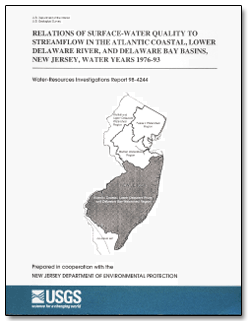Water-Resources Investigations Report 98-4244
ABSTRACT
Relations of water quality to streamflow were determined for 18 water-quality constituents at 28 surface-water-quality stations within the drainage area of the Atlantic Coastal, lower Delaware River, and Delaware Bay Basins for water years 1976-93. Surface-water-quality and streamflow data were evaluated for trends (through time) in constituent concentrations during high and low flows, and relations between constituent concentration and streamflow, and between constituent load and streamflow, were determined. Median concentrations were calculated for the entire period of study (water years 1976-93) and for the last 5 years of the period of study (water years 1989-93) to determine whether any large variation in concentration exists between the two periods. Medians also were used to determine the seasonal Kendall's tau statistic, which was then used to evaluate trends in concentrations during high and low flows. Trends in constituent concentrations during high and low flows were evaluated to determine whether the distribution of the observations changes through time for intermittent (nonpoint storm runoff) and constant (point sources and ground water) sources, respectively. High- and low-flow trends in concentrations were determined for some constituents at 26 of the 28 water-quality stations. Seasonal effects on the relations of concentration to streamflow are evident for 10 constituents at 14 or more stations. Dissolved oxygen shows seasonal dependency at all stations. Negative slopes of relations of concentration to streamflow, which indicate a decrease in concentration at high flows, predominate over positive slopes because of dilution of instream concentrations from storm runoff. The slopes of the regression lines of load to streamflow were determined in order to show the relative contributions to the instream load from constant (point sources and ground water) and intermittent sources (storm runoff). Greater slope values indicate larger contributions from storm runoff to instream load, which most likely indicate an increased relative importance of nonpoint sources. Load-to-streamflow relations along a stream reach that tend to increase in a downstream direction indicate the increased relative importance of contributions from storm runoff. Likewise, load-to-streamflow relations along a stream reach that tend to decrease in a downstream direction indicate the increased relative importance of point sources and ground-water discharge. The magnitudes of the load slopes for five constituents increase in the downstream direction along the Great Egg Harbor River, indicating an increased relative importance of storm runoff for these constituents along the river. The magnitudes of the load slopes for 11 constituents decrease in the downstream direction along the Assunpink Creek and for 5 constituents along the Maurice River, indicating a decreased relative importance of storm runoff for these constituents along the rivers. |
For additional information contact: Part or all of this report is presented in Portable Document Format (PDF); the latest version of Adobe Reader or similar software is required to view it. Download the latest version of Adobe Reader, free of charge. |
Hunchak-Kariouk, Kathryn, Buxton, D.E., and Hickman, R.E., 1999, Relations of surface-water quality to streamflow in the Atlantic Coastal, Lower Delaware River, and Delaware Bay Basins, New Jersey, water years 1976-93: U.S. Geological Survey Water-Resources Investigations Report 98-4244, 146 p.
Abstract
Introduction
Methods of study
Relations of surface-water quality to streamflow
Analysis of relations by constituent
Comparison of results
Summarys
References cited
Appendixes 1-18. Relations of constituent concetnration and load to streamflow and trends
in concentration with time (Available on CD-ROM from U.S. Geological Survey, New Jersey District (609-771-3900):
Appendix 1--Alkalinity
Appendix 2--Hardness
Appendix 3--Total organic carbon
Appendix 4--Suspended sediment
Appendix 5--Dissolved solids
Appendix 6--Dissolved sodium
Appendix 7--Dissolved chloride
Appendix 8--Dissolved oxygen
Appendix 9--Fraction of dissolved oxygen at saturation
Appendix 10--Total phosphorus
Appendix 11--Total nitrogen
Appendix 12--Total nitrate plus nitrite
Appendix 13--Total nitrite
Appendix 14--Total ammonia plus organic nitrogen
Appendix 15--Total ammonia
Appendix 16--Total boron
Appendix 17--Total lead
Appendix 18--Total coliform bacteria